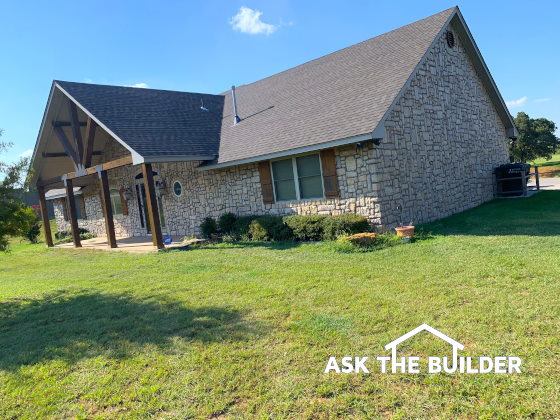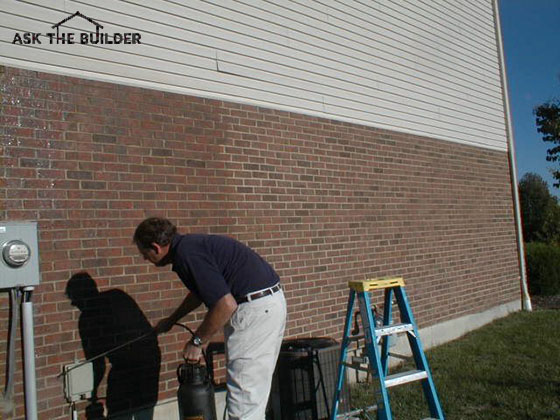Artificial Stone is Not Waterproof

Artificial Stone is Not Waterproof | Artificial stone like this on the outside of a home is not waterproof. (C) Copyright 2019 Tim Carter
This is not a normal column of mine. I’m sitting in my man cave writing this column several hours before I talk to Amanda on the phone. She lives in Oklahoma and her new home covered with artificial stone made from colored and textured concrete is leaking when it rains and the wind blows. These are common conditions in many places in the USA as well as the Great Plains. I’ve offered a simple phone consult service for years to homeowners in distress so they can get the straight answer from someone who doesn’t have a dog in the fight.
I’m really troubled by Amanda’s plight because each week the number of serious defects I hear about from homeowners just like you is growing, and growing fast. The reasons for the defects are many. As insane as this sounds, I’m even dealing with this situation within my own family as my daughter’s new dream home construction project has turned into a nightmare. I’m not building her home because she lives too far away from me.
Allow me to share with you why Amanda’s new home is leaking water. Just an hour ago, I watched a video Amanda sent me where she showed me her waterlogged exterior wall sheathing as well as wet wood studs. It was hard to watch because I know how easy it is to ensure rainwater never ever touches wood exterior wall framing. When I was a young builder I had the luxury of taking apart older homes. I saw how the builders and carpenters from 100-150 years ago used basic building materials and techniques to keep houses dry for decades.
It’s important to realize that wind-driven rain penetrates brick-veneer, solid brick walls, artificial stone, and just about any other masonry material. The water almost always enters through nearly invisible cracks where the mortar touches the masonry material.
The Brick Industry Association (BIA) created years ago a series of technical notes that shows how to build homes and other buildings that stay dry inside. You can get access to these technical notes at their gobrick.com website at no cost. You use the same best practices when working with artificial stone, real stone, concrete block or any other exterior masonry material.
Builders hundreds of years ago knew that brick leaked water. This is why they used different types of brick to build solid-masonry buildings. The brick you see on the outside of the structure was fired harder and longer in the kiln and didn’t normally absorb much water at all. But the brick used behind the face brick was a softer less-hard brick that was quite absorbent.
When the rain got past the outer layer of brick through the mortar joints, the inner layer of brick acted like a temporary reservoir. As soon as the rain stopped and the sun came out, the water inside the brick wall would wick out to the atmosphere. It was an ingenious system learned no doubt the hard way over a few centuries.
Today brick or stone is almost always a non-structural element on homes. Extra care has to be taken to construct the home so the water that gets through the mortar is collected and redirected to the exterior without ever touching the wood framing. All of the methods to achieve this goal are outlined in the technical notes you, as well as your builder and mason, can get from the BIA.
Amanda’s artificial stone dilemma is not easy to rectify. The best way to solve the problem is to remove all the stone and start over with the correct detailing using waterproof membranes and flashings above and below all windows and doors. But this is not realistic. Very few people can afford to do this and Amanda’s builder is not going to do the honorable thing and correct the problem. Heck, he probably won’t even do it right the second time, but I digress.
 Amanda will probably have to apply several coats of a silane-siloxane water repellent on her stone facing. This might solve the problem. If not, she may have to apply a thicker clear sealant that’s brushed on the mortar and overlapped onto the artificial pieces of stone.
Amanda will probably have to apply several coats of a silane-siloxane water repellent on her stone facing. This might solve the problem. If not, she may have to apply a thicker clear sealant that’s brushed on the mortar and overlapped onto the artificial pieces of stone.
How can you avoid becoming a statistic like Amanda and my daughter? It’s not easy. My daughter, who did everything right including extremely detailed plans and specifications still got ensnared in the net of a builder who didn’t bid the project right and only wants to go work on jobs where he can make money. My daughter should have moved in three months ago. Right now her drywall is still not complete. Her house sits for days with no one working there.
You need to have fantastic plans and written specifications to start. Another key point is to have a meeting with your builder before he bids the project and review every aspect of the house and make sure he understands what needs to be done. Include great photographs with your plans, if you can get them, showing exactly what you want each part of your house to look like when complete. These photos help communicate the level of quality you expect.
Be sure you include a penalty clause so each day the builder is late, you deduct a certain amount from his final bill. Don’t get trapped into giving the builder more money at any point than he deserves. If you do this, there could still be $80,000 worth of work to do but only $40,000 in your construction loan account. Be careful!
Column 1318
One Response to Artificial Stone is Not Waterproof